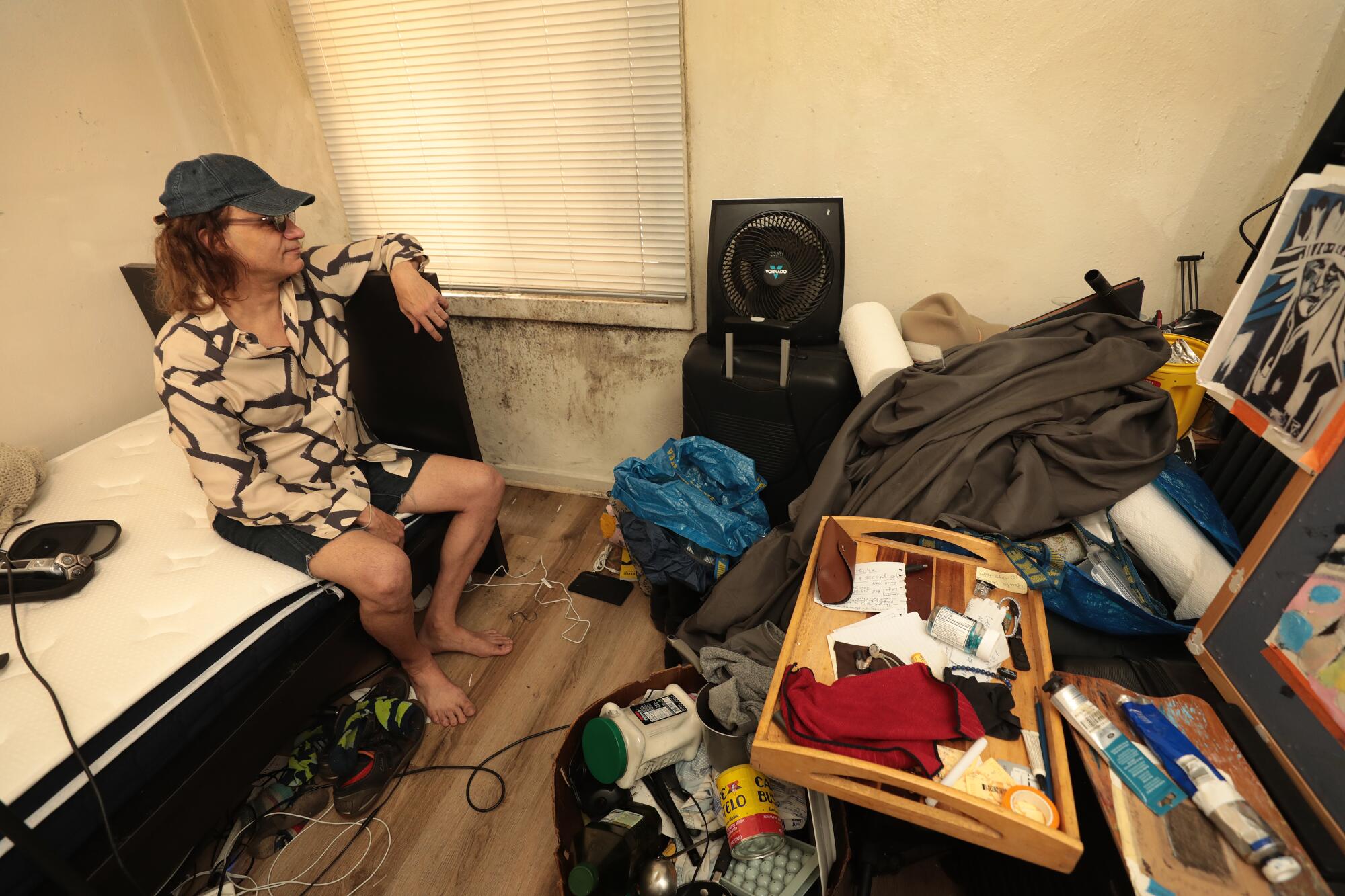
- Share via
A homeless person is handed the keys to a room.
They can stay there at least a year — perhaps their first opportunity for stable housing in a long time. The room is lightly furnished, but a case manager will help them pick out more and show them how to fold their clothes neatly in a drawer or hang them up in the closet.
Maybe there’s an aching tooth or swollen eyelid they’ve been ignoring for a while. They’ll head downstairs to a nurse, who can examine them and help make a doctor or dental appointment.
Maybe they’re angry after a neighbor took something they left in the hall. Maybe they get into a fight in the kitchen. A security worker de-escalates the situation, and a social worker helps them take some deep breaths. A therapist talks to them about what happened. Tells them it’ll be OK.
This is the ideal for permanent supportive housing, a model of subsidized housing combined with support services that has shown to be a promising strategy in reducing chronic homelessness. When a homeless person is housed, it can take a village for them to thrive.
After moving into their apartments, Big Mama, Top Shelf, and other former residents of the homeless encampment find life indoors difficult.
In Los Angeles, there are several nonprofits that have built this kind of support system for their residents. But the for-profit Cecil Hotel in downtown Los Angeles, which reopened as housing for the homeless at the end of 2021, has struggled to do the same.
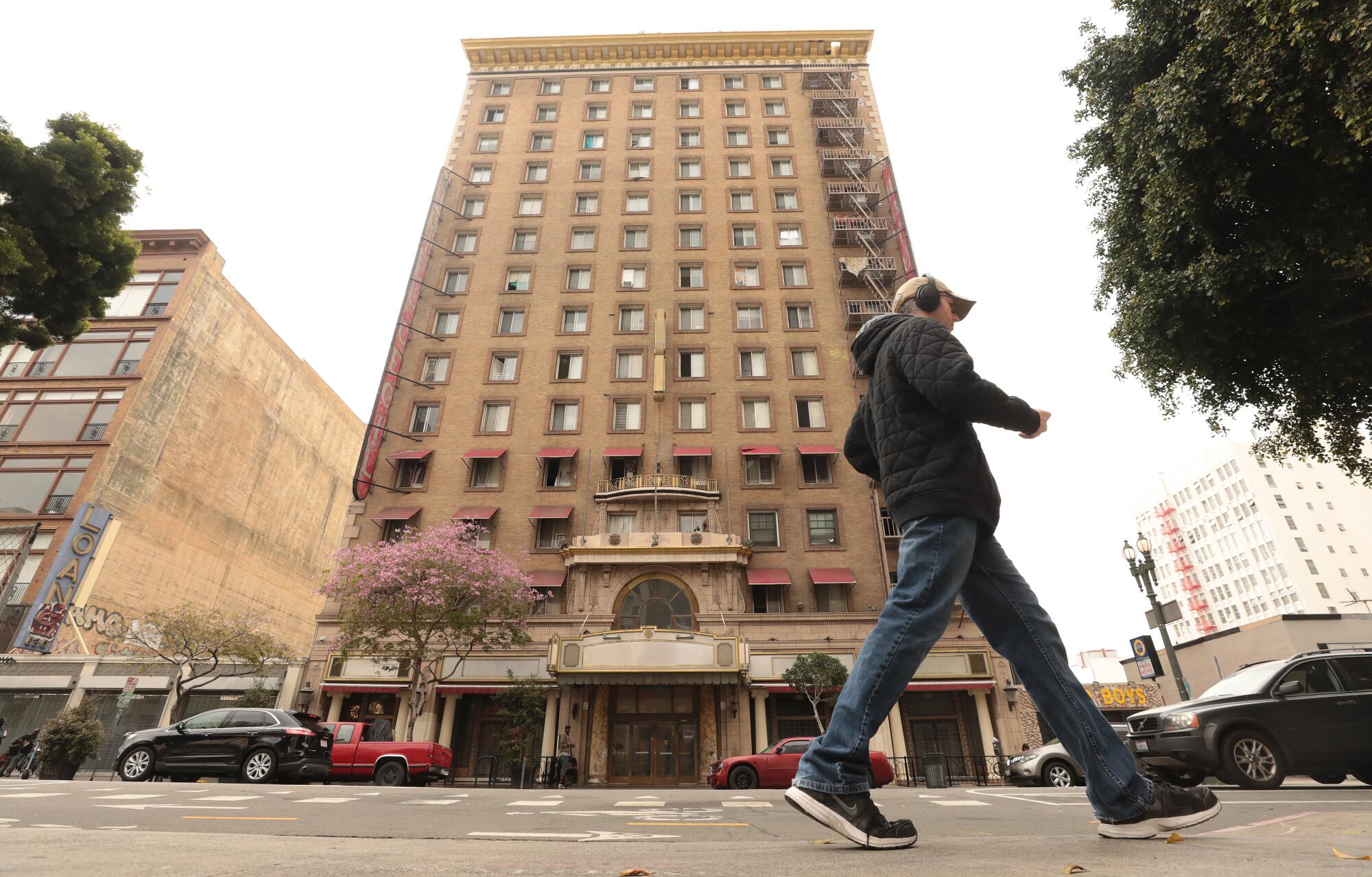
Many who live in the Cecil say they feel abandoned. They’re worried about mold in their rooms, nonfunctioning elevators and piles of trash that build up in the hallways.
Without an on-site service provider or adequate staffing, the building has devolved into chaos, they say: Mice and roaches scurry around corners, violence leads to broken glass, and no one seems to care.
When the historic hotel a few blocks from Skid Row reopened as 600 housing units, it held immense promise as a model of how private developers could help alleviate the homelessness crisis by using the city’s existing stock of single room occupancy units.
The Cecil opened its doors to people who had been rejected by landlords wary of accepting tenants who’d lived on the streets. At 160 square feet, the rooms have a bed, nightstand, dresser and mini fridge. Some have their own bathrooms, but most residents use the communal bathrooms on each floor. The building is about half full: It has 318 residents and 75 people on deck to move in.
The building’s managers say that issues are to be expected when housing recently homeless people and that they’re working on bringing in more support services for the residents. The intention had been to have an on-site service provider before anyone moved in, but that didn’t come together, and they didn’t want the rooms to sit empty.
All of the Cecil’s residents receive rental subsidies, with some in programs funded through the Los Angeles Homeless Services Authority or the county Department of Health Services, and others with an emergency housing voucher distributed by the federal government during the COVID-19 pandemic. The federal vouchers pay for most or all of someone’s rent and can be used anywhere, as long as the unit passes inspection by the local housing authority.
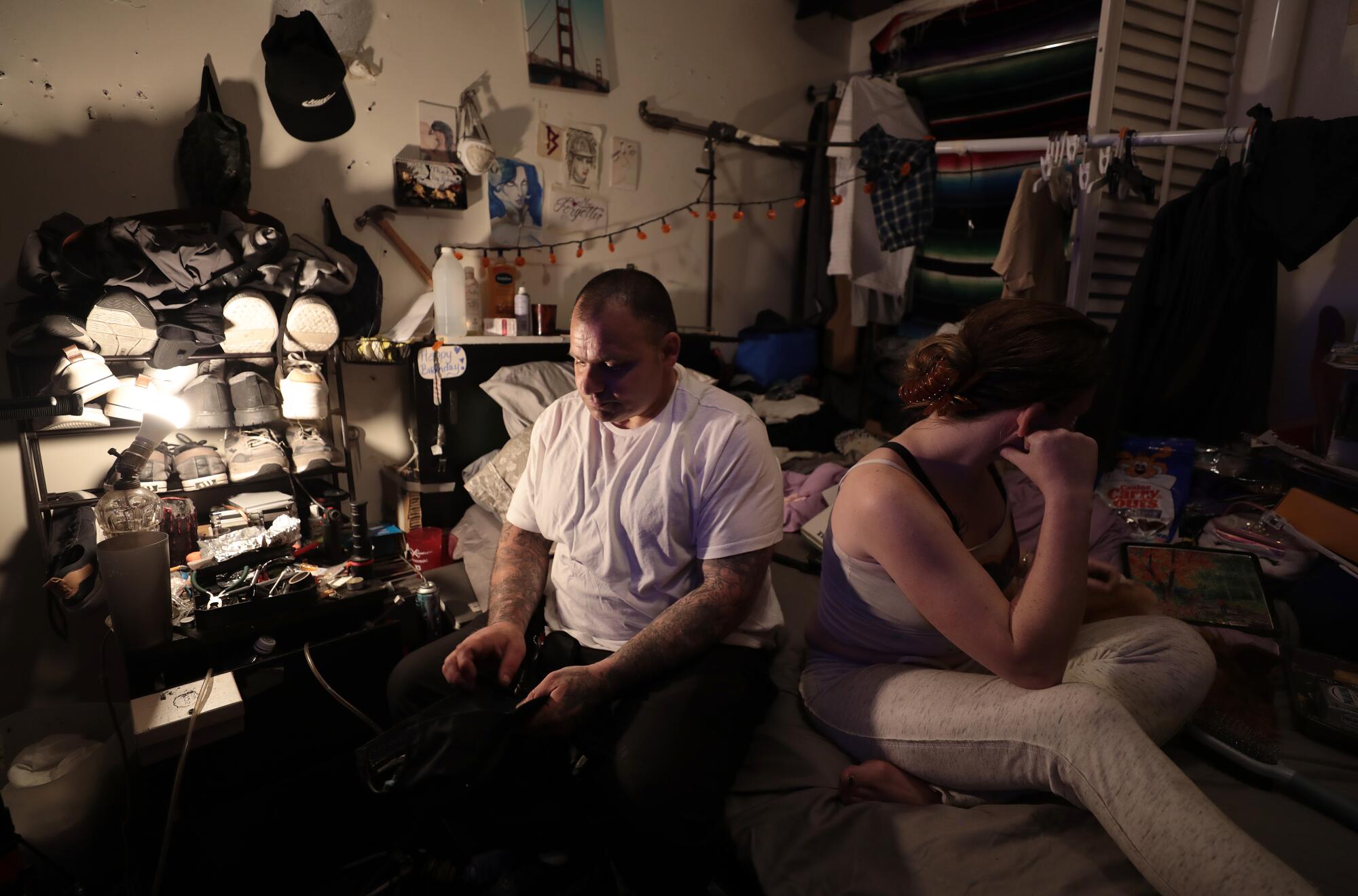
With the help of one of those vouchers, Richard Silva moved into the Cecil a year ago.
On a spring afternoon, he’s sitting in his room, the air heavy with the smell of cigarette smoke.
A lamp in the corner barely illuminates the space crowded with hanging bikes, shoes stacked high on racks and an assortment of furniture he’s collected. The floor is covered with piles of odds and ends, and it’s unclear which are prized possessions and which are trash.
There’s art taped to the walls. Silva proudly displays his sketchbooks and says he’s a tattoo artist, but these days he spends most of his time panhandling.
Silva says he was supposed to receive $250 for furniture and clothes but never got the money. He’s not sure where it was supposed to come from, nor does he know whom to contact about it. He thinks it was written in his lease, but he can’t find the documents.
There are spots of mold by his sink and toilet, as well as on the ceiling. He points out how a bubble under the paint on his ceiling dribbles water once in a while, but says that’s better than the steady stream that flowed during last winter’s rainstorms.
At 48, Silva has been homeless nearly half his life. Right before moving into the Cecil, he stayed in a house through Hope of the Valley Rescue Mission, a nonprofit that runs shelters and tiny-home villages. When asked about a case manager, he shrugs.
Rowan Vansleve, Hope of the Valley’s chief financial officer, said his organization doesn’t have funding to keep in touch with clients after they’ve found a place to live.
Several of the other organizations that have placed residents at the Cecil have the same limitation, according to Deena Eberly, managing director of Eberly Co., which manages the building.

Funding to maintain supportive services at housing projects is often piecemeal and difficult to navigate.
Money can come from Measure H, L.A. County’s 2017 voter-approved tax for funding homeless services; that pool of funds is managed by the county’s Homeless Initiative and distributed through the county Department of Health Services. Money can come from the Los Angeles Homeless Services Authority, which awards federal dollars to local nonprofits. Mental health services funding can come from the county Department of Mental Health, and support for military veterans can come from still other avenues.
Residents of permanent supportive housing projects usually have their rent covered by vouchers that are attached to the building, which means they can’t take that funding with them if they choose to move elsewhere. In that setup, the organization operating the housing project applies for a batch of vouchers that will subsidize rents for all the units in the project and seeks funding for supportive services for all residents who need them.
The Cecil operates differently. It’s set up to house people who already have government funding in hand and need a place to call home. Prospective tenants apply to live there individually, just like at a regular apartment building, and their rental subsidies come from varied sources. At the start, the Cecil couldn’t predict who might end up in the building, so it had trouble planning what kinds of services they might need.
Dora Gallo, from nonprofit housing operator A Community of Friends, said that when her group applies for public funding to build a housing project, one of the first things it must do is describe its plan to offer services to the eventual residents.
“You can’t put people in apartments that have not really lived in an apartment setting for a while without providing the services,” Gallo said. “It’s not just about putting people in housing, it’s making sure people have all the tools they need to succeed in housing.”
To do so, Gallo said, her organization needs to apply for philanthropic grants and fund-raise heavily to fill in the gaps when county funding falls short.
“It’s never enough and it doesn’t pay for everything,” Gallo said.
People Assisting the Homeless, an organization that operates permanent supportive housing across California, does the same. L.A. County pays the group, which is known as PATH, to provide case management for a certain number of people every month. Any ancillary services such as on-site clinicians and life skills classes have to be funded through private grants, said Tescia Uribe, PATH’s chief program officer.
Many of the 3,000 people and families in L.A. who have received the emergency vouchers remain in limbo.
When the city and county of Los Angeles received several thousand emergency housing vouchers from the federal government in July 2021, none of them came with funding for those services.
“It was like ‘Just get people inside.’ There weren’t the resources for the retention part of it and stabilization,” Uribe said. “It’s the fallout of that that we see now.”
L.A. County provided funding for 2,100 of those voucher holders to receive case management services, which includes at least one or two drop-in visits per month.
Fifty of those are at the Cecil, but many of the building’s other residents are without case managers. Several residents said they felt like they didn’t have anyone to turn to for help because their case manager left the job and they didn’t get assigned a new one, or that they lost their case manager’s business card. Others said they don’t bother keeping in contact because they don’t think their case manager would be able to help them.
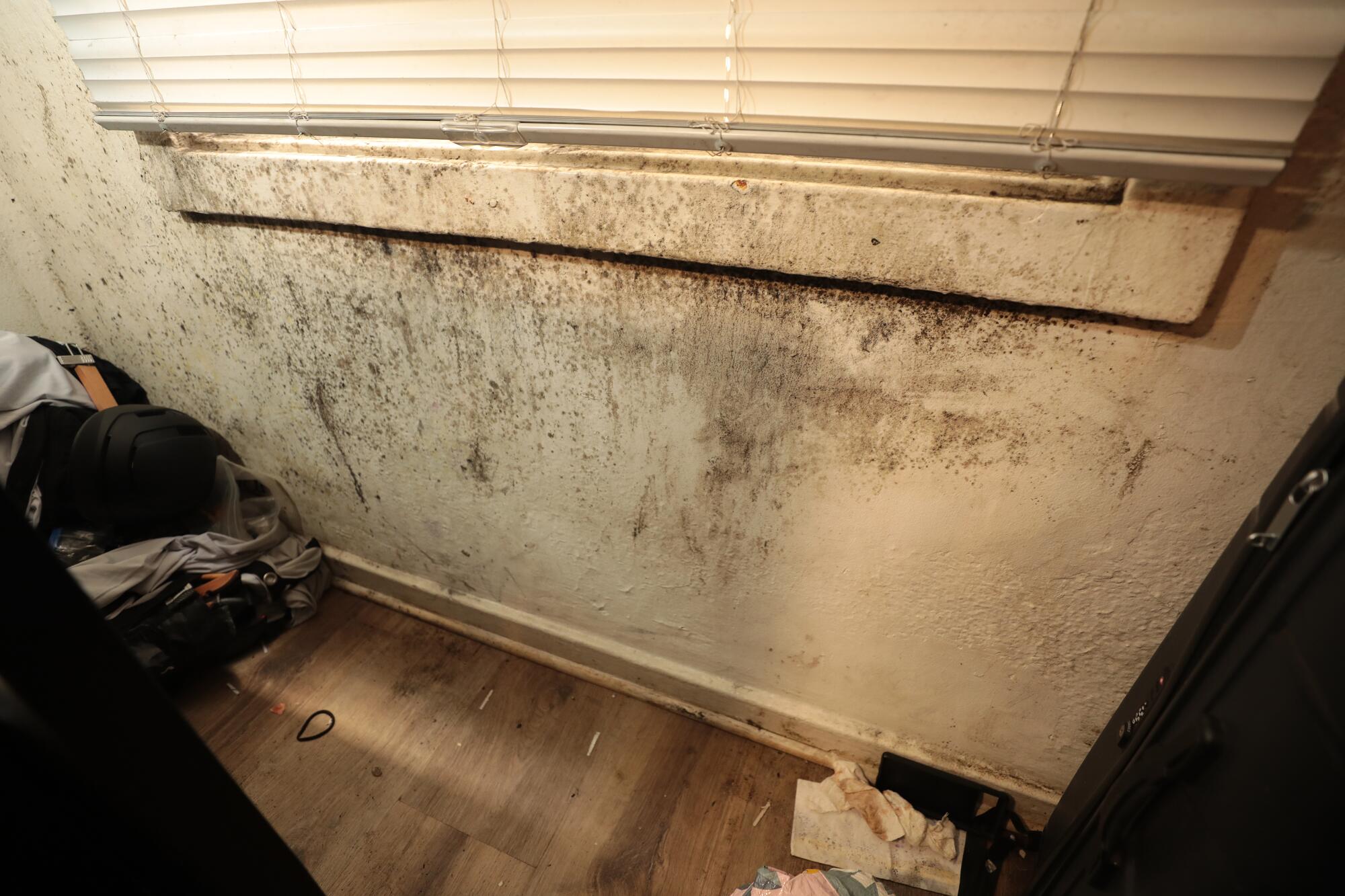
For the last few months, the nonprofit JWCH Institute, funded through the county, has been offering some physical and mental health care at the Cecil. Its mobile clinic parks in front of the building twice a week.
These limited resources starkly contrast with the practice of “critical time intervention,” which emphasizes that individuals need to be “bombed” with support as soon as they get housing, Uribe said.
To address mental and physical health, deal with substance abuse and learn the social and financial skills necessary for living in an apartment, they need immediate support from all directions, according to Uribe. By tackling those issues head-on, PATH has a 90% retention rate over three years for its housing, she said.
“A lot of people don’t remember how it is to take a shower, they don’t remember how to take care of themselves, so they need that extra help,” Uribe said. “They’re also coming off living off trauma, looking over their shoulders all the time.”
Without that immediate support, things can quickly deteriorate.
Jebediah Maxwell, who moved into the Cecil in October, stopped cooking in the building’s communal kitchen this summer when he discovered the roaches. He couldn’t stomach it after seeing them come out of the oven, and recently he’s gotten multiple reports of mice on various floors.
The building’s management hired him to be a tenant liaison so residents can bring up any issues they have, but he’s tired and frustrated, saying the management is not responsive enough. He quit last week.
One of the two elevators at the Cecil has been out of service for months, and the other elevator breaks at least once a week, he said. He keeps putting in maintenance requests for the laundry room, which contains two washers and two dryers for the entire building to share. Tenants have reported mold in their rooms and say the communal bathrooms are constantly dirty.
In recent months, he said, violence has gotten markedly worse.
“I just got assaulted by a tenant,” Maxwell said in July. “Second time I’ve been assaulted in the past two months.”
He said he’s seen many people in the building he doesn’t recognize as tenants, who have caused disturbances and made residents feel unsafe. There are also several residents who have become increasingly physically aggressive, he said, including one who broke a seventh-floor window.

Tracii Thompkins, who lives on that floor, said the window was covered in aluminum foil for a month before it was repaired.
“I honestly feel like they don’t care at this point,” she said of the building’s management.
Thompkins goes to sleep every night with towels stuffed under her door in an effort to keep the roaches out. But they make their way in during the day while she’s gone.
When she needs to use the bathroom, she finds herself going to other floors because the ones on her floor are always dirty or clogged, she said.
“There are literal tissues that somebody wiped their butt with and stuck it on the wall,” she said. “It’s been stuck on the wall for months.”
It’s not uncommon to see animal feces and urine in the hallways either. Some residents who own dogs don’t take them outside, Thompkins said.
The building has seven full-time workers on its janitorial and maintenance staff, with one more who comes in periodically. They’ve been fighting a losing battle.
Leslie Morales, who works in the Cecil’s management office, said that when housing people who haven’t had homes in a while, issues are to be expected.
“They’re learning,” Morales said. “They have been on the street for too long.”
The elevator problems come from tenants and visitors who cause damage by dropping items in the crack between the elevator car and doors or by slamming on the buttons, she said. There aren’t enough washers and dryers, she admitted, but she also pointed to tenants: Those who don’t budget enough money for laundry overfill the machines and cause them to break, she said.

Many of the issues are also caused by tenants’ mental health or tenants not knowing how to express themselves properly, she said.
Morales described an incident from several months ago in which a 10th-floor resident clogged his sink, left the water running and left the room. The water flooded his room and reached all the way down to the sixth or seventh floor, she said.
Building issues can be harder to catch when housing the homeless because “the residents don’t say what’s going on,” she said.
Morales said the four staff members in management end up cleaning up messes when needed — which is frequently. Trash cans often overflow between visits from maintenance workers. And — perhaps unsurprisingly, because people with hoarding problems face a higher risk of becoming homeless — piles of furniture and boxes build up in the Cecil’s hallways.
“We are a leasing company but we’ve become … therapists, support, everything,” Morales said. “We have to end up doing janitorial.”
Los Angeles housing officials are planning to step in with immediate help to stabilize residential buildings that the financially strapped Skid Row Housing Trust is unable to maintain in habitable condition.
These maintenance issues contribute to the cost of operating the building.
Residents are grateful for a roof over their heads and a place to call their own, but living conditions are becoming intolerable.
“They’re like prison cells,” Maxwell said. “That’s what the majority of us feel like.”
The Cecil project has run into several difficulties since its inception, from negotiating rent with the city’s housing authority to getting tenants’ vouchers approved. And it seemed to encounter a lukewarm response, at first, from some of the city’s network of nonprofit partners, which the Cecil relies on to usher potential residents through its doors.
Matthew Baron, president of Baron Property Group, which owns the Cecil, said the plan always had been to have a service provider for its residents.
“The idea was originally to find a service provider before we actually started the lease-up,” Baron said.
The Cecil initially partnered with Skid Row Housing Trust to try to find one for the building and figure out how the support would be funded, he said, but that didn’t work out. The Cecil terminated its relationship with the trust in December 2022, shortly before the trust’s financial collapse.
Meanwhile, it started welcoming tenants. With more than 40,000 people experiencing homelessness in the city — and with the empty building eating away at his bottom line — Baron didn’t want to wait.
“I don’t think it’s the right thing for us to be just sitting on vacant units,” Baron said, “not letting people come in off the street just because we haven’t found the service provider yet.”
Now, he said, his team is working on fixing the problems that have cropped up.
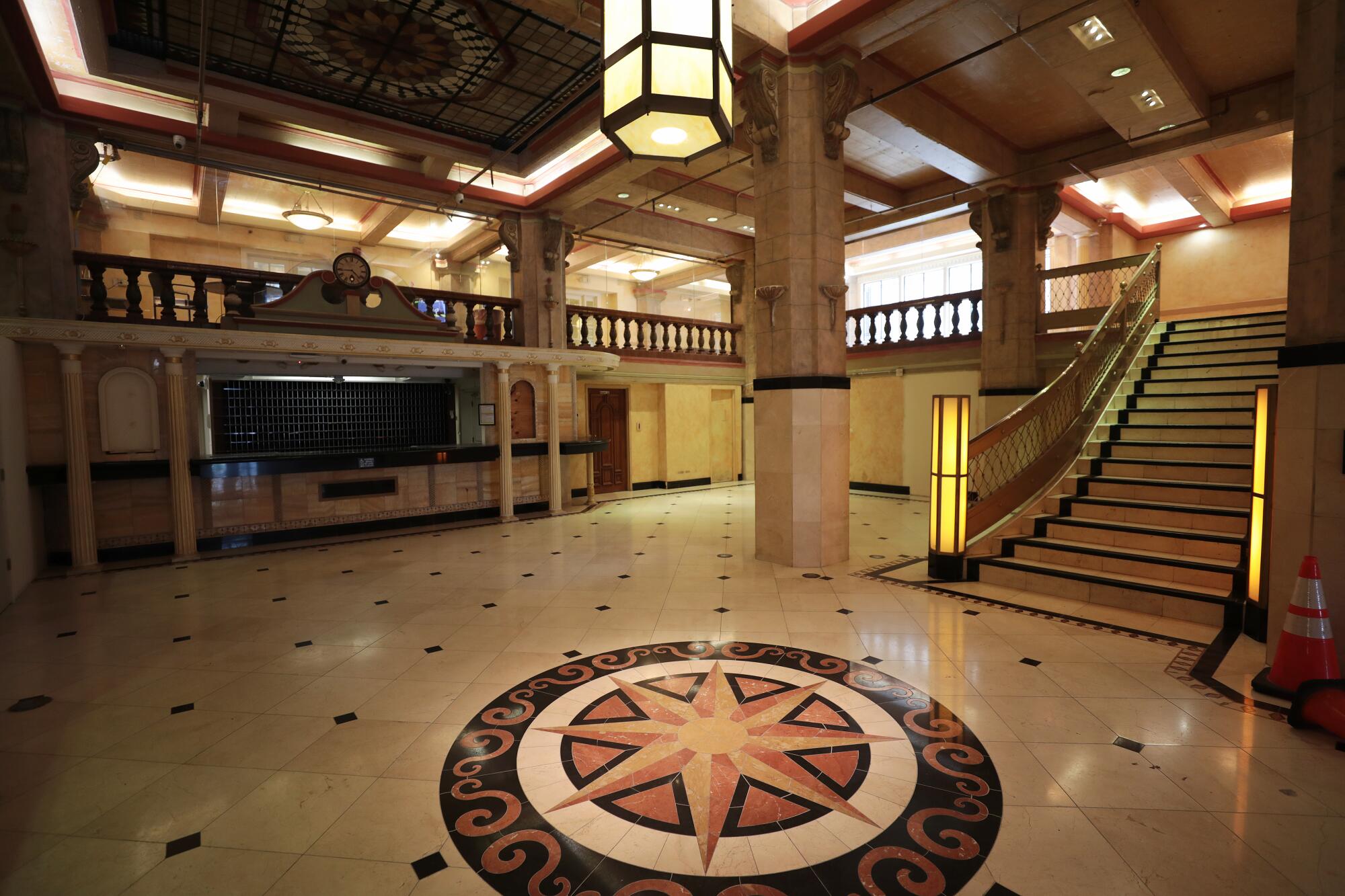
The Cecil is building a much larger laundry room, and it has two pest control contracts in place to deal with the vermin. It’s also starting a volunteer program for residents to help alert management to problems on their floor.
“We are absolutely committed to making the Cecil a safe and clean space for people to live… [and] making sure the people who live at the Cecil are provided the services that they need,” Baron said.
He’s also looking to fill up the building as quickly as possible.
The Cecil is working with PATH to fill 161 rooms and provide supportive services for those residents.
On the ground floor, JWCH will open a site for the county’s Safe Landing program, a 24/7 operation allowing any homeless individual to walk in and access food and resources, and operate 100 rooms of interim housing. The goal is to have the beginnings of those two programs in place by Sept. 1.
“We’re not done,” Baron said. “We’re kind of just still in the third or fourth inning.”
Case management services will continue to depend on individual tenants’ relationships with other organizations, but the Cecil plans for JWCH to offer on-site physical and mental health care to all tenants. JWCH leaders hope to have those clinical services up and running by November — nearly two years after the Cecil began bringing in residents.

More to Read
Inside the business of entertainment
The Wide Shot brings you news, analysis and insights on everything from streaming wars to production — and what it all means for the future.
You may occasionally receive promotional content from the Los Angeles Times.














